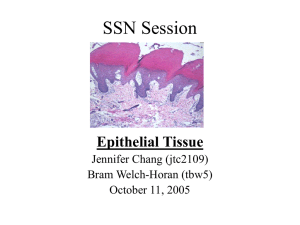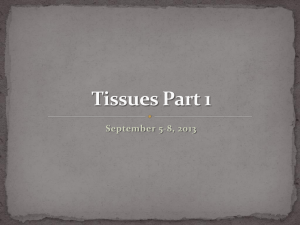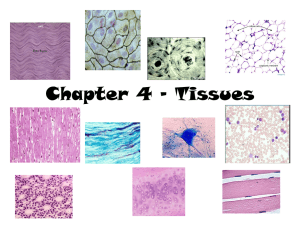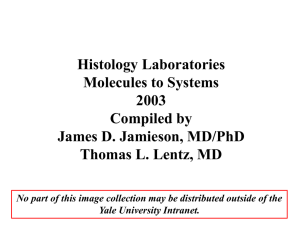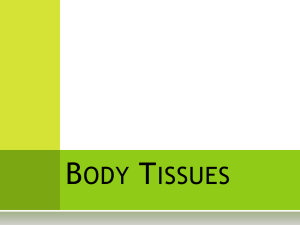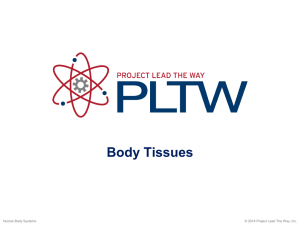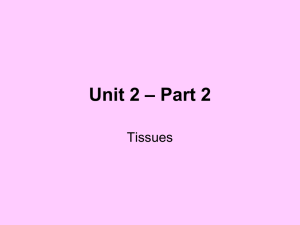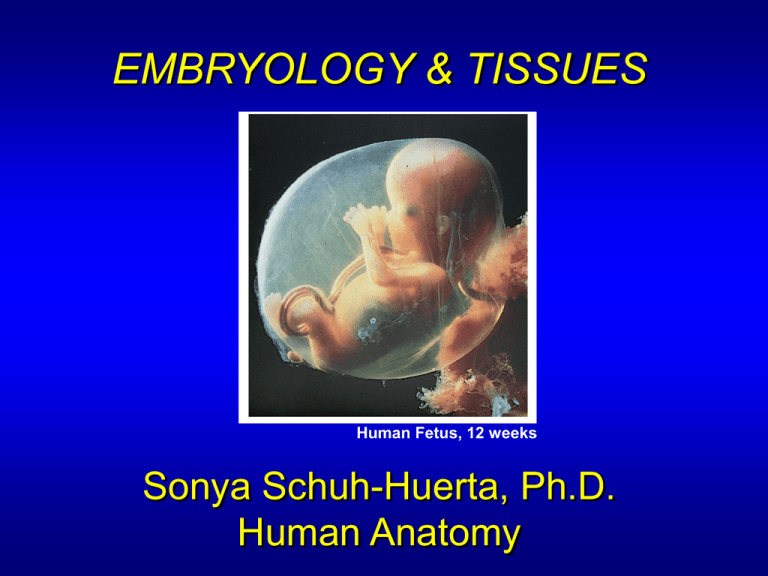
EMBRYOLOGY & TISSUES
Human Fetus, 12 weeks
Sonya Schuh-Huerta, Ph.D.
Human Anatomy
Basic Embryology, Ch 3
Fertilization & the Early Embryo
(Physiology, Silverthorn, 2000)
Embryology
• Embryology – study of the origin & development
of a single individual
• Prenatal period
– Embryonic period first 8 weeks
– Fetal period remaining 30+ weeks
The Prenatal Period
Embryo
Fertilization
1-week
3-week
conceptus embryo
(3 mm)
5-week embryo
(10 mm)
8-week embryo
(22 mm)
Embryonic period
Duration: First 8 weeks post-fertilization
Major events: Organs form from 3 primary germ layers.
The basic body plan emerges.
12-week fetus
(90 mm)
Fetal period
38
weeks
Duration: Weeks 9–38 (or birth)
Major events: Organs grow in size and complexity.
The Basic Body Plan
•
•
•
•
•
Skin dermis and epidermis
Outer body wall trunk muscles, ribs, vertebrae
Body cavity & digestive tube (inner tube)
Kidneys & gonads deep to body wall
Limbs
The Embryonic Period
• Week 1 from zygote to blastocyst
– Fertilization – in lateral 3rd of uterine tube
– Zygote (fertilized oocyte) – moves toward
uterus
– Cleavage – daughter cells formed from zygote
– Morula – solid cluster of 12–16 blastomeres
– Blastocyst – fluid-filled ball of cells
• Inner cell mass forms embryo
• Trophoblast forms placenta
Week 1: Early Embryonic Development
(a)Zygote
(fertilized egg)
Uterine
tube
(b)4-cell stage
2 days
(d)Early blastocyst
(morula hollows out
and fills with fluid).
4 days
Blastocyst
cavity
Sperm
Fertilization
(sperm
meets and
enters egg)
Oocyte
(egg)
(e)Implanting Blastocyst
(consists of a sphere
of trophoblast cells and
an eccentric cell cluster
called the inner cell
mass). 7 days
Ovary
Trophoblast
Ovulation
Uterus
Endometrium
Cavity of
uterus
Blastocyst
cavity
Inner cell
mass
A Closer Look at Week 1 of Human
Embryo Development
d3.0
d3.5
hESCs
Reijo Pera R, et al. 1999
Embryo Development in Action
Wong C, et al. 2010
Implantation of the Embryo
Wall of
uterus
Cavity of uterus
(a) Day 5:
Blastocyst
floating in
uterine
cavity.
Trophoblast
Amniotic
sac cavity
(d) Day 9:
Implantation
continues; inner
cell mass forms
bilaminar disc.
Epiblast
Hypoblast
Trophoblast
Inner cell mass
(b) Day 6:
Blastocyst
adheres to
uterine wall.
Layers from
trophoblast
Bilaminar
embryonic
disc
Amnion
Trophoblast
Inner cell mass
(c) Day 7:
Implantation
begins as
trophoblast
invades into
uterine wall.
(e) Day 11:
Implantation
complete; amniotic
sac and yolk sac
form.
Amniotic
sac
cavity
Epiblast
Hypoblast
Yolk sac
Week 2: The 2-Layered Embryo
• Bilaminar embryonic disc inner cell mass
divided into 2 sheets
– Epiblast & hypoblast
• Together they make up the bilaminar embryonic
disc
• Amniotic sac formed by an extension of
epiblast
• Filled with amniotic fluid
• Surrounds developing embryo/fetus
Week 2: The 2-Layered Embryo
• Yolk sac – formed by an extension of hypoblast
– Digestive tube forms from yolk sac
– NOT a major source of nutrients for
mammalian embryo
– Tissues around yolk sac
• Give rise to earliest blood cells and blood vessels
Week 3: The 3-Layered Embryo
• Primitive streak = raised groove on the dorsal
surface of the epiblast
• Gastrulation = a process of invagination of
epiblast cells & gives rise to the germ layers
– Begins at the primitive streak
– Forms the 3 primary germ layers!
Week 3: The 3-Layered Embryo
• Three Germ Layers*
– Endoderm – formed from migrating cells that
replace the hypoblast
– Mesoderm – formed between epiblast and
endoderm
– Ectoderm – formed from epiblast cells that
stay on dorsal surface
*All layers derived from epiblast cells
The Primitive Streak Stage
Head end
Cut edge
of amnion
Left
Yolk sac
(cut edge)
Right
Primitive
node
Primitive
streak
Tail end
(e) Bilayered embryonic disc, superior view
Formation of the 3-Layered Embryo
Primitive
node
Amniotic sac
Plane of section
Epiblast cells that migrate
through the primitive node
form the notochord.
Notochord
Yolk
sac
Amnion
Head
Tail
Primitive streak
Ectoderm Embryonic
Mesoderm disc
Endoderm
Epiblast cells
that migrate
through primitive
streak form the
mesoderm layer.
Yolk sac
(a)
Sections
(b) and (c)
Amnion
Right
Left
Ectoderm
Right
Notochord
Left
Invaginating
mesodermal
cells
Mesoderm
Endoderm
Yolk sac
(b) Section through primitive streak
(c) Section anterior to primitive streak
The Notochord
• Primitive node = a swelling at one end of
primitive streak
– Notochord forms from primitive node &
endoderm
• Notochord – defines the body axis
– Is the site of the future vertebral column
– Appears on Day 16
Neurulation
• Neurulation formation of the brain & spinal cord
from ectoderm
– Neural plate = ectoderm in the dorsal midline thickens
– Neural groove = ectoderm folds inward
Neural
fold
Neural
crest
Neural
groove
Somite
(covered by
ectoderm)
Primitive
streak
Neural
groove
Neural
fold
Somite
Intermediate
mesoderm
Coelom
(b) 20 days. The neural folds form by folding of the neural plate
and then deepen, producing the neural groove. Neural fold
cells migrate to form the neural crest. Three mesodermal
aggregates form on each side of the notochord (somite,
intermediate mesoderm, and lateral plate mesoderm). Lateral
plate mesoderm splits. Coelom forms between the two layers.
Lateral plate
mesoderm
Somatic
mesoderm
Splanchnic
mesoderm
Neurulation
Neural tube – hollow tube pinches off into the body
• Cranial part of the neural tube becomes brain
• Maternal folic acid deficiency causes neural tube defects!
Head
Surface
ectoderm
Neural
fold
Neural
crest
Neural
tube
Somite
Somite
Cut
edge of
amnion
Notochord
Tail
(c) 22 days. The neural folds have closed, forming the neural tube
which has detached from the surface ectoderm and lies between
the surface ectoderm and the notochord. Embryonic body is
beginning to undercut.
Neurulation
• Neural crest
– Cells originate from ectodermal cells
– Forms sensory nerve cells
• Induction
– Ability of one group of cells to influence
developmental direction (differentiation) of other cells
Week 4: The Body Takes Shape
• The embryo folds laterally & at the head & tail
– Embryonic disc bulges; growing faster than yolk sac
– “Tadpole shape” by Day 24 after conception
– Primitive gut – encloses tubular part of the yolk sac
• Site of future digestive tube & respiratory structures
Folding of the Embryo
Tail
Head
Amnion
Yolk sac
Future gut
(digestive
tube)
Lateral
fold
(b)
(a)
Ectoderm
Mesoderm
Endoderm
Trilaminar
embryonic
disc
Somites
(seen
through
ectoderm)
Tail
fold
Head
fold
Cut edge
of amnion
(c)
Yolk sac
Hindgut
(d)
Yolk
sac
Neural
tube
Notochord
Primitive
gut
Foregut
Cut edge
of amnion
Week 4: The Body Takes Shape
• Derivatives of the germ layers
– Ectoderm forms:
• Brain, spinal cord, & epidermis
– Endoderm forms:
• Inner epithelial lining of the gut tube
• Respiratory tubes, digestive organs, & bladder
- Mesoderm differentiates further and is more
complex than the other 2 layers
– Somites & intermediate mesoderm
– Somatic & splanchnic mesoderm
The Mesoderm Begins to Differentiate
• Somites – our first body segments; 40 pairs
– Paraxial mesoderm
• Intermediate mesoderm – begins as a continuous
strip of tissue just lateral to the paraxial mesoderm
– Each segment attached to a somite
• Lateral plate – most lateral part of the
mesoderm
– Coelom – becomes serous body cavities
• Somatic mesoderm – next to the ectoderm
• Splanchnic mesoderm – next to the endoderm
Mesoderm
– Somites divide into:
• Sclerotome
• Dermatome
• Myotome
– Intermediate mesoderm forms:
• Kidneys & gonads
– Splanchnic mesoderm forms:
• Musculature, connective tissues, & serosa of the
digestive & respiratory structures
• Heart & most blood vessels
– Somatic mesoderm forms:
• Dermis of skin, bones, & ligaments
The Germ Layers in Week 4
Tail
Ectoderm
Head
Mesoderm
Endoderm
Somatic
mesoderm
Somite
Intermediate
mesoderm
Coelom
Future gut
(digestive
tube)
Notochord
Lateral fold
(a) Embryo, day 24
Yolk
sac
Splanchnic
mesoderm
The Germ Layers End of Week 4
Dermatome
Somite
Myotome
Sclerotome
Kidney & gonads
(intermediate
mesoderm)
Splanchnic
mesoderm
Visceral serosa
Smooth muscle
of gut
Peritoneal cavity
(coelom)
Neural tube
(ectoderm)
Epidermis
(ectoderm)
Gut lining
(endoderm)
Somatic
mesoderm
Limb bud
Parietal
serosa
Dermis
Ectoderm
Mesoderm
(b) Embryo, day 28
Endoderm
Germ Layers & Their Adult Derivatives
Ectoderm
Mesoderm
Skin
Epidermis
Dermis
Endoderm
Vertebral
column
Inner tube
Lining of
digestive tube
Kidney
Rib
Muscle of
digestive tube
Outer body
wall
Visceral serosa
Peritoneal cavity
(c) Adult
Spinal
cord
Trunk
Trunk muscles
Parietal serosa
Major Derivatives of Germ Layers
A 4-Week Embryo
Ear
Pharyngeal arches
Eye
Heart
Upper limb bud
Tail
Lower limb bud
Somites (soon
to give rise to
myotomes)
(a)
(b)
Developing Fetus
Developmental Events of Fetal Period
Developmental Events of Fetal Period
Developmental Events of Fetal Period
THE TISSUES, Ch 4
Tissues
• Cells work together in functionally-related groups
called tissues
• Tissue
– A group of closely associated cells that perform related
functions & are similar in structure
4 Basic Tissue Types &
Their Functions
•
•
•
•
Epithelial tissue covering (Chs 4 & 5)
Connective tissue support (Chs 4, 5, 6, & 9)
Muscle tissue movement (Chs 10 & 11)
Nervous tissue control (Chs 12–16 & 25)
Epithelial Tissue
• Covers a body surface or
lines a body cavity
• Forms parts of most glands
• Functions of epithelia:
– Protection
– Diffusion
– Absorption, secretion, & ion transport
– Filtration
– Forms slippery surfaces
Special Characteristics of Epithelia
• Cellularity
– Cells separated by minimal extracellular material
• Specialized contacts
– Cells joined by special junctions
• Polarity
– Cell regions of the apical surface differ from the basal
surface
Special Characteristics of Epithelia
• Support by connective tissue
• Avascular, but innervated
– Epithelia receive nutrients from underlying
connective tissue
• Regeneration
– Lost cells are quickly replaced by rapidly
dividing cells; many stem cells
Special Characteristics of Epithelia
Cilia
Narrow
extracellular
space
Microvilli
Apical region of
an epithelial cell
Cell junctions
Tight junction
Adhesive belt
Desmosome
Gap junction
Epithelium
Nerve ending
Connective
tissue
Capillary
Basal region
Basal
lamina
Basement
Reticular
membrane
fibers
Classifications of Epithelia
• First name of tissue indicates number of cell
layers
– Simple one layer of cells
– Stratified more than one layer of cells
Classifications of Epithelia
• Last name of tissue describes shape of cells
– Squamous = cells are wider than tall (plate-like)
‘squashed’ = squamous
– Cuboidal = cells are as wide as tall (like cubes)
– Columnar = cells are taller than they are wide
(like columns)
Classifications of Epithelia
Apical surface
Basal surface
Squamous
Simple
Apical surface
Cuboidal
Basal surface
Stratified
(a) Classification based on number
of cell layers
Columnar
(b) Classification based on cell shape
Simple Squamous Epithelium
• Description: single layer; flat cells with discshaped nuclei
• Function:
– Passage of materials by passive diffusion & filtration
– Secretes lubricating substances in serosae
• Location:
– Renal corpuscles
– Alveoli of lungs
– Lining of heart, blood, & lymphatic vessels
– Lining of ventral body cavity (serosae)
Simple Squamous Epithelium
(a) Simple squamous epithelium
Description: Single layer of flattened
cells with disc-shaped central nuclei
and sparse cytoplasm; the simplest
of the epithelia.
Air sacs of
lung tissue
Function: Allows passage of materials
by diffusion and filtration in sites where
protection is not important; secretes
lubricating substances in serosae.
Nuclei
of squamous
epithelial
cells
Location: Kidney glomeruli; air sacs
of lungs; lining of heart, blood vessels,
and lymphatic vessels; lining of ventral
body cavity (serosae).
Photomicrograph: Simple squamous epithelium
forming part of the alveolar (air sac) walls (200).
Simple Cuboidal Epithelium
• Description:
– Single layer of cube-like cells with large, spherical
central nuclei
• Function:
– Secretion & absorption
• Location:
– Kidney tubules, secretory portions of small glands,
ovary surface
Simple Cuboidal Epithelium
(b) Simple cuboidal epithelium
Description: Single layer of
cubelike cells with large, spherical
central nuclei.
Simple
cuboidal
epithelial
cells
Function: Secretion and absorption.
Basement
membrane
Location: Kidney tubules; ducts
and secretory portions of small
glands; ovary surface.
Connective
tissue
Photomicrograph: Simple cuboidal epithelium
in kidney tubules (430).
Simple Columnar Epithelium
• Description: single layer of column-shaped
(rectangular) cells with oval nuclei
– Some have cilia at their apical surface
– May contain goblet cells
• Function:
– Absorption; secretion of mucus, enzymes, & other
substances
– Ciliated type propels mucus or reproductive cells by
ciliary action
Simple Columnar Epithelium
• Location:
– Non-ciliated form
• Lines digestive tract, gallbladder, ducts of some
glands
– Ciliated form
• Lines small bronchi, uterine tubes, & uterus
Simple Columnar Epithelium
(c) Simple columnar epithelium
Description: Single layer of tall cells
with round to oval nuclei; some cells
bear cilia; layer may contain mucussecreting unicellular glands (goblet
cells).
Simple
columnar
epithelial
cell
Function: Absorption; secretion of
mucus, enzymes, and other substances;
ciliated type propels mucus (or
reproductive cells) by ciliary action.
Location: Nonciliated type lines most
of the digestive tract (stomach to anal
canal), gallbladder, and excretory ducts
of some glands; ciliated variety lines
small bronchi, uterine tubes, and some
regions of the uterus.
Basement
membrane
Photomicrograph: Simple columnar epithelium
of the stomach mucosa (1150).
Pseudostratified Columnar
Epithelium
• Description:
– All cells originate at basement membrane
– Only tall cells reach the apical surface
– May contain goblet cells & cilia
– Nuclei lie at varying heights within cells
• Gives false impression of stratification!
Pseudostratified Columnar
Epithelium
• Function: secretion of mucus; propulsion of
mucus by cilia
• Locations:
– Non-ciliated type
• Ducts of male reproductive tubes
• Ducts of large glands
– Ciliated type
• Lines trachea and most of upper respiratory tract
Pseudostratified Ciliated Columnar
Epithelium
(d) Pseudostratified columnar epithelium
Cilia
Mucus of
goblet cell
Description: Single layer of cells of
differing heights, some not reaching
the free surface; nuclei seen at different
levels; may contain mucus-secreting
goblet cells and bear cilia.
Pseudostratified
epithelial
layer
Function: Secretion, particularly of
mucus; propulsion of mucus by ciliary
action.
Location: Nonciliated type in male’s
sperm-carrying ducts and ducts of large
glands; ciliated variety lines the trachea,
most of the upper respiratory tract.
Photomicrograph: Pseudostratified ciliated
columnar epithelium lining the human trachea (780).
Trachea
Basement
membrane
Stratified Epithelia
• Properties
– Contain 2 or more layers of cells
– Regenerate from below (basal layer)
– Major role is protection
– Named according to shape of cells at apical
layer
Stratified Squamous Epithelium
• Description:
– Many layers of cells are squamous in shape
– Deeper layers of cells appear cuboidal or
columnar
– Thickest epithelial tissue
• Adapted for protection from abrasion
Stratified Squamous Epithelium
• 2 types keratinized & non-keratinized
• Keratinized
– Location: epidermis
– Contains the protective protein keratin
– Waterproof
– Surface cells are dead and full of keratin
• Non-keratinized
– Forms moist lining of body openings
Stratified Squamous Epithelium
• Function: Protects underlying tissues in areas
subject to abrasion
• Location:
– Keratinized – forms epidermis
– Non-keratinized – forms lining of mucous
membranes
•
•
•
•
•
Esophagus
Mouth
Anus
Vagina
Urethra
Stratified Squamous Epithelium
(e) Stratified squamous epithelium
Description: Thick membrane composed
of several cell layers; basal cells are
cuboidal or columnar and metabolically
active; surface cells are flattened
(squamous); in the keratinized type, the
surface cells are full of keratin and dead;
basal cells are active in mitosis and
produce the cells of the more superficial
layers.
Function: Protects underlying tissues
in areas subjected to abrasion.
Location: Nonkeratinized type forms the
moist linings of the esophagus, mouth,
and vagina; keratinized variety forms the
epidermis of the skin, a dry membrane.
Stratified
squamous
epithelium
Nuclei
Basement
membrane
Connective
tissue
Photomicrograph: Stratified squamous epithelium
lining the esophagus (430).
Stratified Cuboidal Epithelium
• Description: generally 2 layers of cube-shaped
cells
• Function: protection
• Location:
– Ducts of:
• Mammary glands
• Salivary glands
• Largest sweat glands
Stratified Cuboidal Epithelium
(f) Stratified cuboidal epithelium
Description: Generally two
layers of cubelike cells.
Basement
membrane
Function: Protection
Cuboidal
epithelial
cells
Location: Largest ducts of sweat
glands, mammary glands, and
salivary glands.
Duct
lumen
Photomicrograph: Stratified cuboidal epithelium forming
a salivary gland duct (285).
Stratified Columnar Epithelium
• Description: several layers; basal cells usually
cuboidal; superficial cells elongated
• Function: protection & secretion
• Location:
– Rare tissue type
– Found in male urethra & large ducts of some
glands
Stratified Columnar Epithelium
(g) Stratified columnar epithelium
Description: Several cell layers;
basal cells usually cuboidal;
superficial cells elongated
and columnar.
Basement
membrane
Function: Protection; secretion.
Stratified
columnar
epithelium
Location: Rare in the body; small
amounts in male urethra and in large
ducts of some glands.
Urethra
Photomicrograph: Stratified columnar epithelium
lining of the male urethra (315).
Underlying
connective
tissue
Transitional Epithelium
• Description:
– Has characteristics of stratified cuboidal &
stratified squamous
– Superficial cells dome-shaped when bladder
is relaxed, squamous when full
• Function: permits distension of urinary organs
by contained urine and also expansion of uterus
• Location: epithelium of urinary bladder, ureters,
proximal urethra, uterus
Transitional Epithelium
(h) Transitional epithelium
Description: Resembles both
stratified squamous and stratified
cuboidal; basal cells cuboidal or
columnar; surface cells dome shaped
or squamous-like, depending on
degree of organ stretch.
Transitional
epithelium
Function: Stretches readily and
permits distension of urinary organ
by contained urine.
Location: Lines the ureters, bladder,
and part of the urethra.
Basement
membrane
Connective
tissue
Photomicrograph: Transitional epithelium lining the bladder,
relaxed state (390); note the bulbous, or rounded, appearance
of the cells at the surface; these cells flatten and become
elongated when the bladder is filled with urine.
Questions?
What’s Next?
Lab: Embryos and Tissues
Mon Lecture: Tissues cont.; Skin
Mon Lab: Tissues & Skin
Rhythm of Life
Dave Henniker



